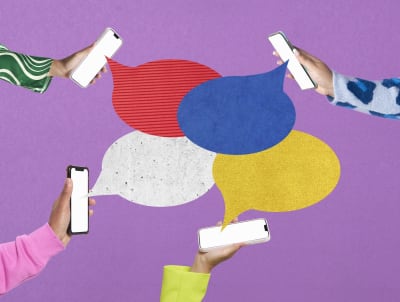5 New Marketing Rules That Are Redefining Brand Success
In an era of digital disruption, old principles no longer apply.

Over the past several years, brands have been forced to operate against the backdrop of profound, persistent digital disruption. During this short period, we witnessed a behavioral and technological revolution that previously would have taken more than a decade to accomplish.
For brands, this means long-standing marketing rules no longer apply. Traditional tactics must evolve to reflect the new behaviors, preferences, and priorities of the people brands serve and the platforms they use.
In my time working with brands from Acura to J.M. Smucker and Samsung during this time of disruption, I’ve arrived at five new truths to help modern marketers successfully navigate this era of inescapable change.
Truth #1: The concept of “above/below the line” is dead.

In the traditional marketing world, a typical campaign started “above the line”—which is to say with a 60-second broadcast spot.
Now, as people choose to spend more time on digital channels and the captive audiences on these platforms grow, the proverbial line has disappeared. Commercials are out; content is in.
Recent stats around marketing spend reflect this shift to digital: According to data from the latest edition of The CMO Survey, released in March 2023, companies spent more than half (53.8%) of total marketing budgets on digital marketing.
Rather than beginning with a 60-second commercial, brands must now begin with the consumer they wish to reach. An impactful campaign starts by understanding where people are spending their time, what their mindset is, and what their motivations are.
This focus on the consumer—as opposed to content or channel—is how brands can reach priority audiences in meaningful and scalable ways and forge real, human connections.
Truth #2: Brands must develop a universe of content. Everywhere. All the time.

Historic launches and events once created huge peaks of excitement that anchored a brand campaign.
Now, as the world becomes increasingly digital, brands need to think of a campaign not as a series of activities but as a persistent experience. Digital content is not a singular destination, so much as an ecosystem—a surround sound of dynamic, responsive, and even predictive experiences that reach priority audiences in whatever mindset or context they are in.
And that can mean truly anything, just about anywhere: from new powerhouse platforms like TikTok to niche communities on Subreddit threads or YouTube comment sections, to new creator networks like Bluesky and hyper-specific Substacks, Discord servers, and Mastodon posts.
This requires brands to create and curate a digital consumer ecosystem that is dynamic, responsive, and radically relevant—one that reflects the evolving mindsets of their audiences.
For example, this past spring, I received a message from Boden, a British women’s and children’s clothing brand, giving me the ability to opt out of Mother’s Day campaign elements. It was a simple yet powerful communication that demonstrated a level of thoughtfulness toward its customers and awareness of cultural conversations. This radical relevance is something that will help to create a positive perception of the brand for the people they are trying to build loyalty with—consumers who see themselves as empathetic, aware, and engaged.
Truth #3: The consumer funnel, as we know it, has collapsed.

Just a few short years ago, brands could easily distinguish different phases of the customer journey and the different channels where those actions were taking place. Now, as people spend more time on social channels, the lines between phases of the consumer funnel are blurring. People rapidly progress from discovery, intent to purchase, and purchase—all on the same channel at nearly the same time.
People rapidly progress from discovery, intent to purchase, and purchase—all on the same channel.
The impact of this trend is expected to be amplified in the coming years, as time spent on mobile devices and social platforms is expected to escalate. According to the most recent Mobile Data Traffic Outlook issued by Ericsson, the global monthly average usage per smartphone is projected to reach 19 GB in 2023 and soar to 46 GB by the end of 2028—a 142% increase.
This growth, coupled with a retreat from ad-sponsored feeds to private spaces and communities, will only make digital more critical for brands to remain competitive in the market and relevant to consumers.
Because it has become increasingly difficult to drive people through a traditional experience, brands must establish a presence where their audiences are prioritizing their time to maximize opportunities for serendipitous discovery. This is why brands are increasingly interested in commerce enablement technologies like AR and in-feed social commerce.
Truth #4: Existing digital engagement playbooks no longer apply.

For the first time in nearly a decade, the so-called digital advertising duopoly—Google and Meta—no longer received the majority of digital ad dollars. In 2022, ad spending on these two platforms accounted for a combined total of 48.4% of spending in the U.S., marking the first time that spending dipped below 50% since 2014.
This is a significant departure for most established brands. But at the same time, this disruptive context creates new brand opportunities. For example, as people spend time on new platforms like TikTok, we see brands leveraging trending topics and sounds to engage communities with compelling content. On the gaming platform Roblox, brands are realizing a significant revenue opportunity by connecting with communities in new and exciting ways.
This expansion of digital media is changing the definition of what it means for brands to show up in unexpected places to intercept and capture audiences. And with the advent of generative AI, brands now need to get ready for another new frontier—LLM chatbot experiences that become the living embodiment of the brand’s purpose and mission.
Truth #5: Today’s creators are tomorrow’s media networks.

The creator economy is putting pressure on agencies to evolve “old” ways of working when it comes to influencer marketing and content creation for social platforms.
While creator networks may not be as robust as those of influencers, they are every bit as valuable—perhaps even more so given their high level of engagement. Some 50 million people worldwide consider themselves a creator, with the total creator economy topping an estimated $104.2 billion as of 2023. This market opportunity grew 119% over the past two years—making it one of the fastest-growing business sectors in history.
But creator content isn’t just part of the future for brands. It can also be part of their success. More than 60% of consumers have used online communities to decide what products to buy, revealing that the fundamentals of the creator economy belong at the core of campaigns.
Creators must be a part of your content mix if you want to reach your audience in an impactful way. This is one of the reasons why our company launched the RZF Creator Collective, a robust service offering designed to connect brands with diverse creators to develop made-for-platform content at the speed of culture.
Forging a clear and compelling path forward to your digital future
For companies all over the world, it has become impossible to escape digital disruption, which means that organizations that want to thrive must learn to embrace it.
But doing so means learning how to operate in a new and rapidly changing environment—one that is already undoubtedly complex and will only become more so as the pace and prevalence of change exponentially increases.


